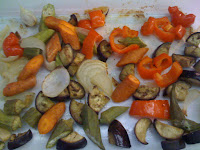
Eating well does not need to be an expensive endeavor. But some people think that eating inexpensively is all about rice and beans!
Not true -- though beans and rice are an inexpensive meal option.
Beans, legumes, and peas cooked badly deserve the negative rap they sometimes get as the cheap food of poor college students. On the other hand, prepared creatively, they are delicious.
Beans, legumes, and peas cooked badly deserve the negative rap they sometimes get as the cheap food of poor college students. On the other hand, prepared creatively, they are delicious.
When I was cooking in Courcheval in the French Alps, beans, legumes and peas were a great energy staple for my chalet guests. The French guests in particular loved them, because believe it or not, French cooking incorporates pulses, elevating something like the humble chic pea to lofty gourmet heights.
Yes, it can be a bit of a pain to soak beans overnight, but last month I suggested trying the power soak which cuts down soaking and cooking time significantly.
Once cooked, legumes can be stored in the fridge (covered) for several days, and used in a variety of ways.
For instance, you probably know that the middle-eastern spread, hummus, is simply cooked chic peas whizzed up with tahini, olive oil, lemon juice, garlic, and water.
For instance, you probably know that the middle-eastern spread, hummus, is simply cooked chic peas whizzed up with tahini, olive oil, lemon juice, garlic, and water.
Chic peas are also a delicious snack on there own. Grab a handful on the run for a great energy boost.
And you don't need to serve rice with chic peas; they can stand on their own as a protein-rich meal or you can serve them with a spicy vegetable side, as I'm proposing in the following meal idea.
Chic Peas with Okra & Eggplant
Chic Peas with Okra & Eggplant
Chic Peas
1) Power soak chic peas, then boil till they're tender.
2) Drain and toss peas into a bowl with whatever veggies you have in your fridge. Using items from the March 19th shopping list, I've added a few chopped cherry tomatoes, some onion, feta cheese, olives, and cilantro.
3) Then toss the lot in a pan with a little oil & garlic, turn the hot plate to low, (the idea is to warm them), and put a lid on while you make the side of vegetables.
2) Drain and toss peas into a bowl with whatever veggies you have in your fridge. Using items from the March 19th shopping list, I've added a few chopped cherry tomatoes, some onion, feta cheese, olives, and cilantro.
3) Then toss the lot in a pan with a little oil & garlic, turn the hot plate to low, (the idea is to warm them), and put a lid on while you make the side of vegetables.

Okra & Eggplant
1) Saute chopped onion and garlic in olive oil till transparent.
2) If you have any eggplant left, chop and add to onions, stirring over med-to-high heat till eggplant starts to brown.
3) Add a teaspoon of cumin (and or coriander) stir it through onions & eggplant. Turn heat to low.
4) Toss in some sliced, frozen okra and put lid on pan so veggies cook slowly in their own juice for about 20-30 mins.
1) Saute chopped onion and garlic in olive oil till transparent.
2) If you have any eggplant left, chop and add to onions, stirring over med-to-high heat till eggplant starts to brown.
3) Add a teaspoon of cumin (and or coriander) stir it through onions & eggplant. Turn heat to low.
4) Toss in some sliced, frozen okra and put lid on pan so veggies cook slowly in their own juice for about 20-30 mins.
To serve: Onto a plate, spoon a good portion of the warm chic peas, next to it, a spoonful of spicy veggies. If you have any cooked polenta leftover, you might slice and warm it, then drizzle it with a little olive oil -- it'll make a delicious accompaniment to this meal.































